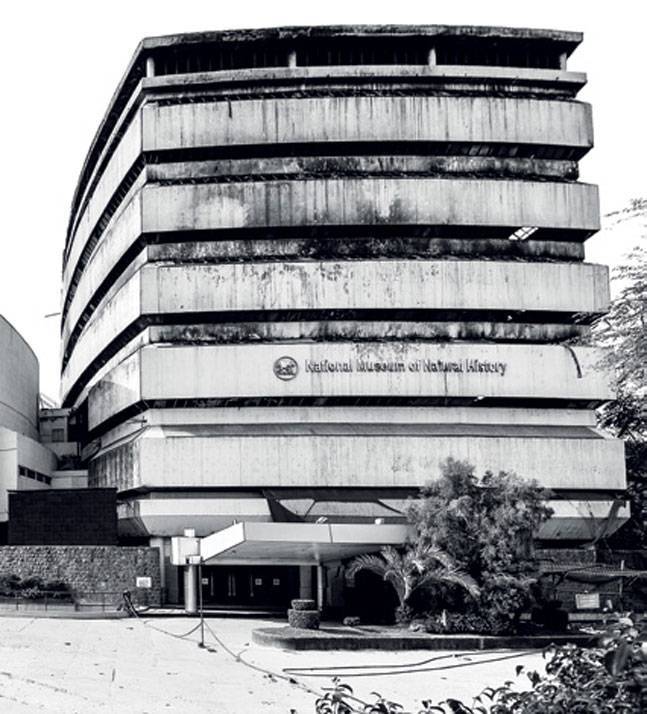Delhi: Monuments (general issues)

For individual monuments please click Places at the bottom of this page and look up under the concerned letter e.g. 'Delhi: J' Or enter the name of the monument in the Search box.
Contents |
After 1947
Varun Shiv Kapur , Brutalist Delhi “India Today” May 12, 2017
AKBAR HOTEL
Architect: Shiv Nath Prasad
Year: 1969
Akbar Hotel in Chanakyapuri is an archetypal brutalist building. Its bold form, heavy massing and straight lines project the no-nonsense attitude of the movement.
IIT DELHI
Architect: JK Chowdhury
Year: 1968
The main academic block of IIT Delhi is one of the city's earliest brutalist structures. This imposing building exudes the requisite seriousness and heft to house one of India's premier academic institutions.
SRIRAM CENTER
Architect: Shiv Nath Prasad
Year: 1969
Shiv Nath Prasad worked on both the Akbar Hotel and the Sriram Center for Performing Arts at Mandi House at the same time. The Sriram Center is the smaller of the two, and plays with its bold massing while still indicating externally the functions of its different interior spaces.
CHANAKYA CINEMA HALL
Architect: PN Mathur
Year: 1970
The side facade of the once iconic and now demolished Chanakya cinema at Chanakyapuri resembled a whale held aloft on columns. This is because its exterior followed the shape of the auditorium inside, and it proudly displayed its structural components on its skin, creating an evocatively shaped building.
HALL OF NATIONS AT PRAGATI MAIDAN
Architect: Raj Rewal
Year: 1972
The recently demolished Hall of Nations was a unique structure. It wore its three-dimensional lattice structural framework unabashedly as its skin, unhidden behind any form of covering. It was essentially a huge shed or hangar, but the aesthetics of its design and engineering elevated it to a thing of raw beauty, and at the time a symbol of India's progressive desires.
FICCI BUILDING (NATIONAL MUSEUM OF NATURAL HISTORY)
Year: 1972
Not many people would call the National Museum of Natural History a thing of beauty. As an unapologetic exposed-concrete building with a severe industrial aesthetic, it fit right in with the other brutalist structures coming up in the 70s. The museum was unfortunately gutted by a fire in 2016.
POLISH EMBASSY
Architect: Witold Ceckiewicz
Year: 1973
While driving down Shanti Path in Chanakyapuri towards Moti Bagh, you might have glimpsed a modernist building whizz past you on the left, just before the last roundabout before the Moti Bagh flyover. This gem is the Polish Embassy, easily one of the most interesting modernist structures in the city.
TIBET HOUSE
Architect: Shiv Nath Prasad
Year: 1974
Like many of the buildings on this list, the Tibet House on Lodhi Road is like a breath of unabashed modernist fresh air in the sea of ho-hum structures. It is an almost square box raised on a smaller base, and one of the more compact examples of exposed concrete, egg-crate facade structures from the 1970s.
NCDC BUILDING AND NDMC PALIKA KENDRA
Architect: Both Kuldip Singh
Year: 1980 and 1983 respectively
These are two later examples of exposed concrete structures in the city, and among the better maintained. Palika Kendra on Parliament Street is a soaring, expressive concrete structure with a curved base, and the NCDC building on Khel Gaon Marg is a quirky stepped-pyramid building. A unifying thread connecting these two buildings, as well as Akbar Hotel, Sriram Center and the Hall of Nations, is the structural engineer associated with all of them: Mahendra Raj, who deserves much credit for the design of these structures.
Category-wise/ types of monuments
Eight types of monuments in Delhi: NMA
FOR FRAMING BYLAWS
The Times of India New Delhi: TIMES NEWS NETWORK Jul 30 2014
Over four years after the new and amended ASI Act was enforced, the process of framing heritage bylaws for Delhi’s protected monuments is taking longer than ever. Only bylaws for Sher Shah Gate and Khair-ul Manzil have been notified, with the process for final notification of Begumpuri Masjid’s bylaws still an ongoing one. Under pressure to speed up the process, National Monuments Authority is looking at eight categories of monuments to identify characteristics of each for framing of common bylaws.
A draft outlining the categories has been prepared to which NMA has invited objections and suggestions from the public. ASI is also being consulted for views. On the list, though, there are only 160 protected monuments existing in Delhi, with the remaining 14 either missing or denotified.
“The draft has been prepared in accordance with regulations of ASI Act. It will eventually be sent to the culture ministry for final phase notification,“ said a top NMA official. The categories are also expected to help in urban development projects in which clearances will be required for monument-controlled areas. The categorization was mostly done internally within NMA, though comments and suggestions were invited from experts from various fields like architecture, conservation, urban planning, etc. Once the categories are notified by the Centre, monuments under various categories will get the official tag. “It will also help in the protection of monuments and increasing tourist foot fall. Monuments that face threats of ur banization and encroachment have been listed separately so that a closer tab can be kept on them,“ said an official.
While Delhi has three world heritage sites--Qutub Minar, Humayun's Tomb and Red Fort, ' ' first category of protected monuments and archaeological sites inscribed S on Unesco's world heritage list also includes monuments like Arab ki Sarai, t Nila Gumbad, Hindu Iron Pillar and Tomb of Afsar-wala which fall in the vi i cinity of these sites.
Category II has ten monuments including Delhi Gate, Ajmeri Gate, Mutiny Telegraph Memorial, and Tomb of Razia Begum which are on a tentative Unesco heritage list.
The third category has ten buildings located in New Delhi area while the fourth category consists of ticketed monuments. Category V only mentions Najaf Khan Tomb as a monument with an adequate flow of visitors identified for charging fee. The sixth category consists of living monuments which receive a large number of visitors and pilgrims and buildings where worship and rituals are conducted.
The seventh category has monuments located in urban/semi-urban limits and remote villages. Sources said this category is critical. It’s further classified in three sub-categories on basis of intensity of urban pressure. While subcategory A has 18 monuments facing severe urban pressure with heavy construction activity in close vicinity, subcategory B has some monuments facing urban pressure but possessing significant greenery.
The final (eighth) category includes archaeological parks
Construction within 100 metres of protected monuments
Jan 2018/ projects halted
Activists Fear Structural Damage To Protected Monuments
A parking lot on Kasturba Gandhi Marg, underground parking at Shahid Bhagat Singh Park, bridge near Salimgarh Fort, tunnel through Sunder Nursery — these infrastructure projects in Delhi have either been scrapped or stalled indefinitely because they fall within 100 metres of protected national monuments. But things are about to change with the Ancient Monuments and Archaeological Sites and Remains Act being amended on Tuesday to keep government and infrastructure projects out of such prohibition zones. Not surprisingly, heritage activists are up in arms, terming the change as sounding the “death knell for Indian heritage”.
The prohibited (100m) and regulated (101-300m) area restrictions were included in the Amasr Act of 1993 in order to safeguard protected monuments. There are 173 of them in the capital, and over 3,600 across the country. The Act was amended in 2010 to set up the National Monuments Authority as the agency to enforce the 100-m ban.
This provision has, however, encountered stiff resistance from sections of the public. Government agencies rue that in a city like Delhi, where heritage structures are common given the city’s antiquity, a ban on constructions in their proximity is an impediment to development. Residents unfortunate enough to be living within these controlled zones grumble that they cannot even repair their houses without permission.
“The actual threat to monuments is not from a few residential houses, but from the huge infrastructure projects which can now be undertaken, thanks to this amendment,” said an alarmed heritage activist. “There will be no one to check the damages that ancient structures will suffer from such development projects. Government agencies anyway have never exhibited sensitivity about protecting heritage.”
Sources confided that the decision to amend the law stemmed from three stalled national projects: an elevated national highway near Akbar’s Tomb in Agra, railway line near Rani ki Vav in in Gujarat and the Kolkata Metro. Work at these sites is expected to proceed at full speed now. “Damage to monuments might not only be visual but also structural,” explained a conservation architect. “It’s a pity the Act has been amended.”
In Delhi, while the National Monuments Authority had cleared projects on a case to case basis, the lifting of the ban on construction could give rise to new projects or revive dormant ones. “The ramifications of the amendment are huge,” said Swapna Liddle, convenor, Intach Delhi Chapter. “Delhi Metro can construct a flyover in front of Qutub Minar and there can be no opposition.”
Liddle said the issue did not involve substantial stretches of land. All that was needed was just 100 metres or so of land around monuments to protect them from vibrations, structural damage and marred aesthetics.
The actual threat to monuments is not from residential houses, but from infrastructure projects which can be undertaken after the new amendment... There will be no one to check the damages that ancient structures will suffer from such development projects.
Missing monuments
The Times of India, Aug 21 2015



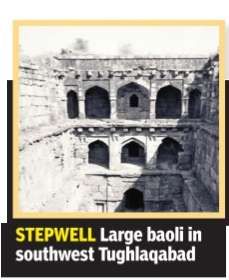



Richi Verma
City's monumental loss
Japanese team retraces steps of archaeological experts who visited Delhi in 1960 and finds many of the monuments they saw missing Until the 1960s, there was a large baoli with four lev els in southwest Tugh laqabad that--although not lined with as many arches as Agrasen ki Baoli near Connaught Place--would have counted among the city's finer mediaeval stepwells.An expanding village swallowed it whole at some point in time. The baoli would have been completely forgotten but for the documents and plate camera images left behind by a Japanese team that surveyed more than 400 monuments over six months during 1959-60. Fifty five years later, another Japanese team is revisiting those monuments to document the changes they have undergone. So far, their findings have been disappointing. In less than 10 days, the five experts have traced about 80 of the loca tions but found that many of the striking mosques and tombs that stood there have disappeared, while many others are barely recognizable today .
“Our aim is to com pare how the monuments and the urban setting around them have changed,“ said Prof Naoko Fukami, director of the Japan Society for Promotion of Science research station in Cairo, who is leading the team as part of a research project.
The 1960 survey team had selected 400 monuments from a list compiled by Maulvi Zafar Hasan in the early-1900s. “Now we want to see how these 400 monuments have evolved since then, she said.
The Japanese team is working with the Delhi chapter of heritage conservation body Intach, which is helping them get permissions from ASI, the state archaeology department and other agencies for visits. It has covered Chirag Dilli, Tughlaqabad, Siri Fort, Hauz Khas and Malviya Nagar and will survey Mehrauli, Nizamuddin, central Delhi and Old Delhi before the project concludes next y e a r.The 1960 team included three historians and a senior professor.
“We found that monuments tend to disappear more in unplanned colonies and villages,“ said Fukami. villages,“ said Fukami.“In Chirag Dilli, a new mosque has come up in place of a Lodhi-era mosque. Only portions of the old wall are visible. Many other monuments have been altered and defaced. The team's research will be compiled in three volumes and serve as reference material for future projects.
Intach officials said the project shows how Delhi's heritage is disap pearing rapidly . “So far we've had the Zafar Hasan list of 1912 which is not very well detailed, and then we came out with the Intach Built Heritage listing in 2000. This survey from 1960 shows how the monu ments have evolved through the decades and is a new reference point for us, said Intach convener Prof AGK Menon.
Intach's director (project) Ajay Kumar said, “Currently, we are working on unprotected monuments and the survey provides new resource material for us. The findings are a matter of concern and need to be addressed.
Monuments of national importance
Shahjahanabad/Old Delhi/ Walled city: Mughal, British monuments
The Times of India, Dec 13 2015


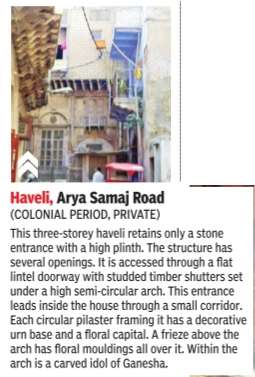








Old Delhi now richer by 300 heritage buildings
RichiVerma
10 UNSUNG GEMS OF WALLED CITY
Every nook and corner of the Walled City has a story to tell--from the sprawling havelis that have witnessed the glory of Mughal and British empires, to the many galis, chowks and bazaars that have evolved over generations. After years of researching and surveying, Indian National Trust for Art and Cultural Heritage (INTACH) has finally completed the challenging task of documenting heritage buildings in the area. There are 1,064 such buildings now-an increase of 300 over the previous list. The new survey lists 303 havelis (mostly owned privately) and other buildings that were overlooked earlier. The municipal corporation had notified 187 Old Delhi properties as protected several years ago. When heritage experts insisted on protection for many more buildings, INTACH published a list of nearly 550 buildings, mostly privatelyownedhavelis, that had unique architectural features. This list is still pending notification with the urban development department. Said an INTACH official. “We started surveying the streets and identifying properties that had historical elements in them-anything from old railings to arches--and listed them for protection. In the final survey we found 303 buildings and havelis. All the properties have been graded in terms of architectural and heritage value. The list includes notable havelis like Namak Haram ki Haveli in Chandni Chowk as well as gateways in Old Delhi's mohallas that had not been included earlier. Most of the properties are from the Colonial period, but some date back to the Sultanate and Mughal eras. Most of the havelis are located in the congested lanes of Sitaram Bazaar, Khari Baoli, Kucha Pati Ram, HauzQazi and the Jama Masjid area.While some are in relatively good condition, many are falling to pieces as their owners have not maintained them. “The objective of the survey was also to identify these heritage havelis and give their owners incentives and support to preserve them. The final list has been sent to Shahjahanabad Redevelopment Corporation, which is framing policies to give incentives to haveli owners for maintaining the buildings as well as financial assistance, said an official.The scheme is open to notified heritage buildings. Only a fourth of the 1,064 listed heritage properties in the Walled City have any kind of protection. In recent times, a number of old havelis have collapsed due to neglect or the impact of unauthorised construction in their vicinity.
Heritage buildings in Delhi: 2nd list
Richi Verma, Heritage gets second wind in Walled City, Jan 14, 2017: The Times of India


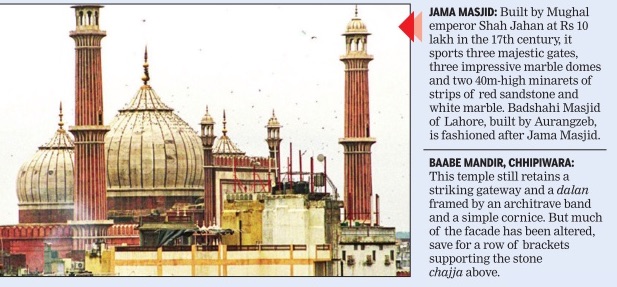
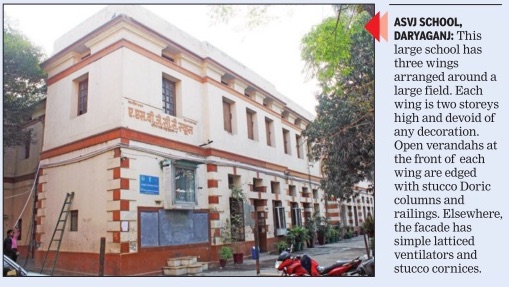

As extraordinary as it may sound, given its historic significance, the 17th century Jama Masjid in Old Delhi never enjoyed official protection. That will change now with the country's largest mosque becoming a protected structure, along with 550 other heritage buildings in the Walled City . Delhi government has notified them under Section 7.26 of Delhi Building Byelaws for Conservation and Protection.
Of the heritage buildings notified in the second list, the first list having come out in 2010, 526 fall under the jurisdiction of the North Delhi Municipal Corporation and 25 under the South Delhi Municipal Corporation. Apart from Jama Masjid, some others slated for protection and conservation are Nigam Bodh Ghat, Anglo-Sanskrit School, Gadodia Market, Ambedkar University offices, CPI(M) office building, the Taj Mahal Hotel on Church Mission Road and the Canara Bank building in Daryaganj.
“Of the 551 buildings, at least 475 buildings are havelis,“ said an official.“Protecting the Walled City's havelis has been a priority for many years. Now, any construction work related to a protected haveli will require the permissions of the municipal corporation and the heritage conservation committee. Left out of the first list, conservationists later felt that the sprawling havelis, most of which had historical elements associated with them, needed protection to prevent any alteration to their original character.
While alteration might no longer be easy , owners of protected havelis would, however, now be eligible to receive government funding for the maintenance of their buildings. Prohibitive maintenance and repair-related costs had led to a large number of Old Delhi's havelis facing decay .
Dec 2017/ Begumpur Masjid, Sarai Shahji Mahal enter list
Aurangzeb may be anathema to the ruling establishment but Tughlaq, it seems, will pass muster. Culture minister Mahesh Sharma told Rajya Sabha that his ministry had declared Begumpur Masjid and Sarai Shahji Mahal, both in Delhi, as monuments of national importance. The move is also expected to tackle complaints received from ASI field offices about unauthorised construction.
Begumpur Masjid is one of the seven mosques said to have been built by Khan-i-Jahan Junan Shah, the prime minister of Firoz Shah Tughlaq who ruled India in the 14th century. Although it resembles the Khirki and Kalan masjids, the single-storey mosque stands on a raised plinth and its large courtyard is enclosed by arched cloisters on all sides and houses a three-aisle deep prayer hall.
The Sarai Shahji Mahal, on the other hand, is a group of monuments which contain a mosque comprising compartments topped by a curved Bengali roof, and a mahal having a courtyard with a few graves surrounded by an arcade and an enclosure containing graves dating back to the late Mughal period.





